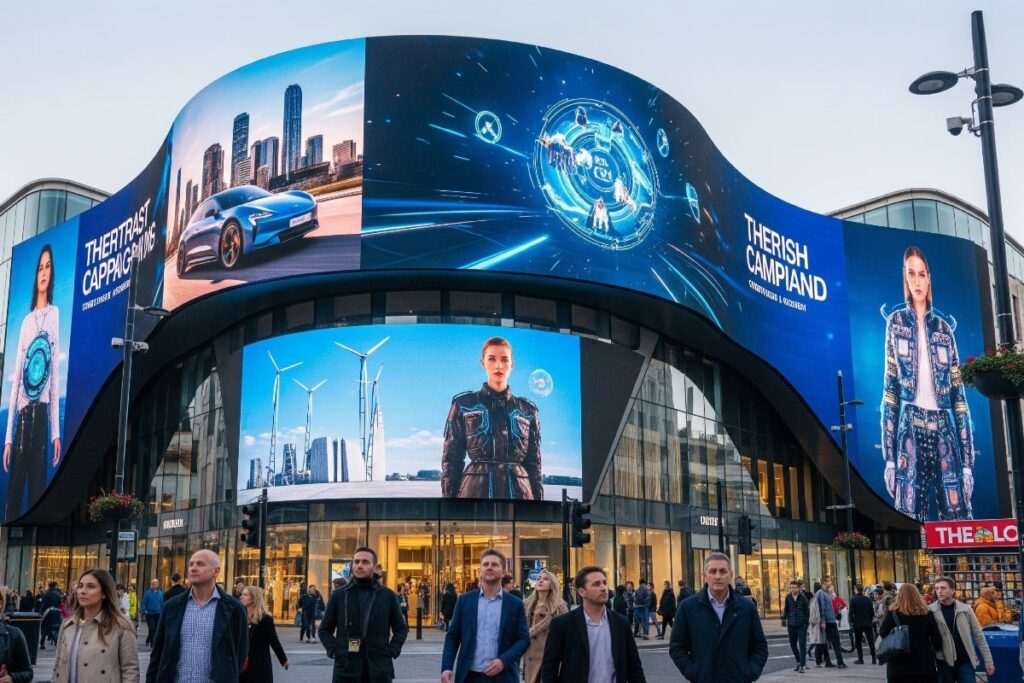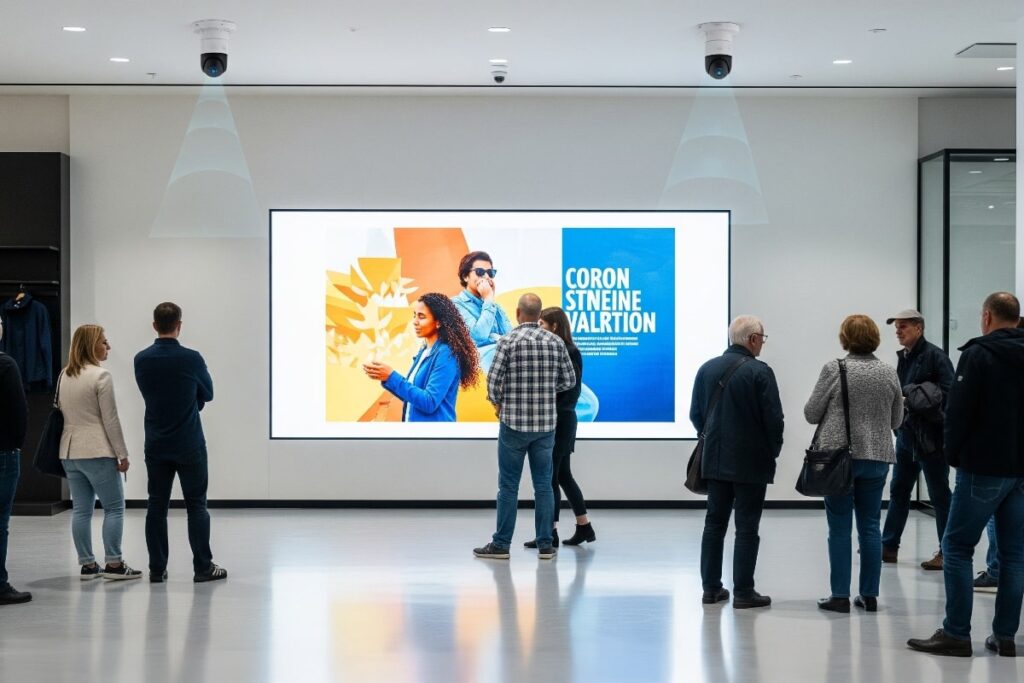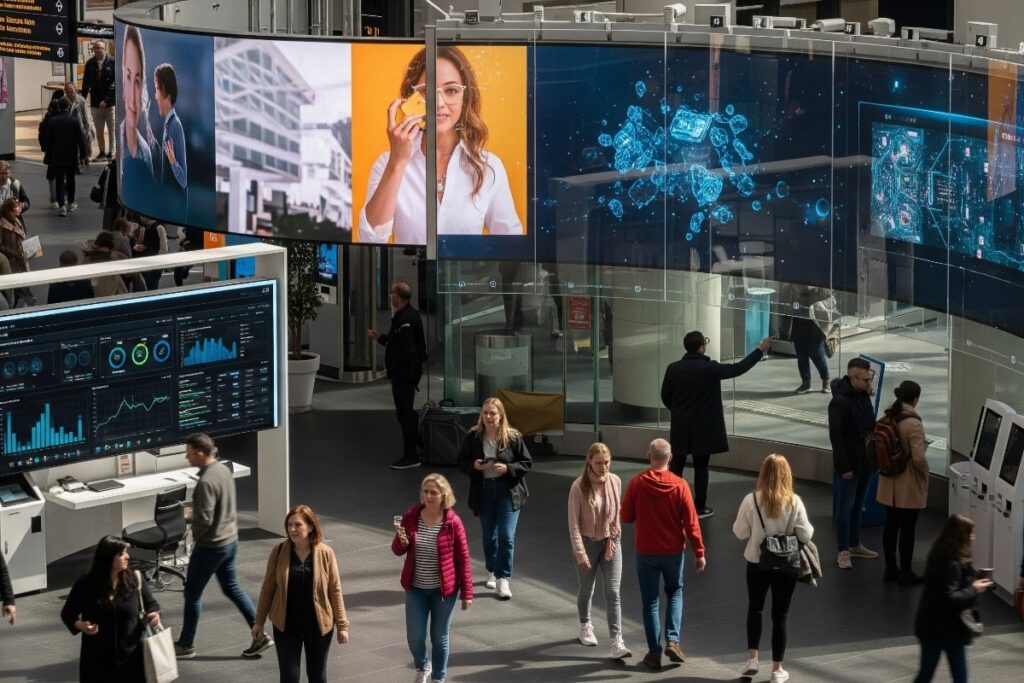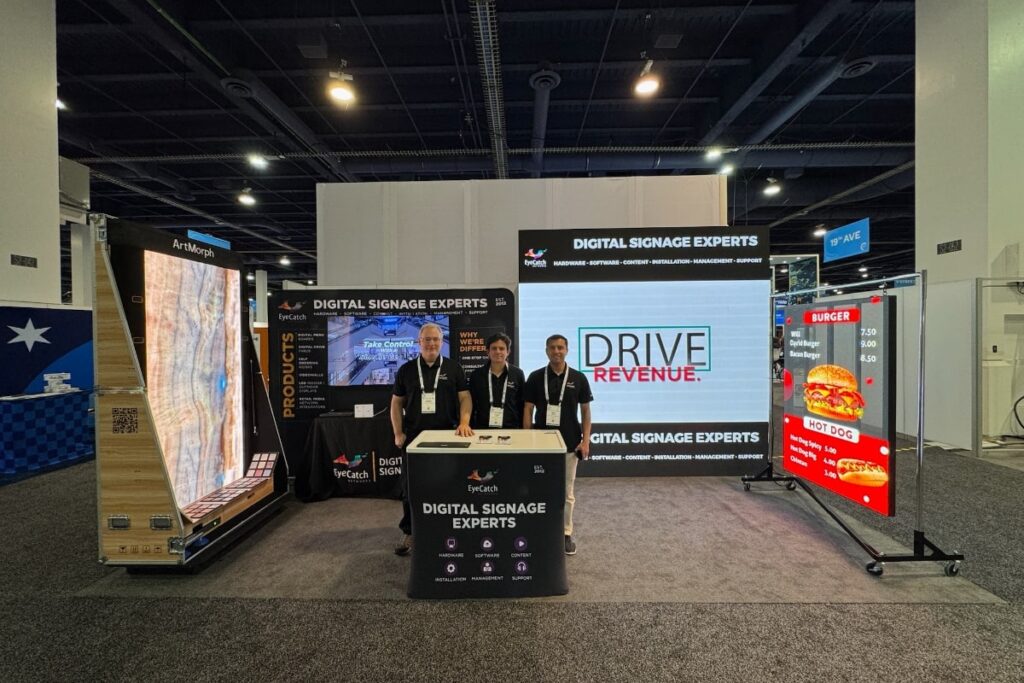Digital signage is transforming the way businesses communicate, engage, and connect with their audiences. But what exactly is digital signage, and how does it differ from traditional signage? At its core, digital signage is the use of electronic displays to deliver dynamic content, from advertisements and promotional messages to operational updates and interactive experiences. Its flexibility, adaptability, and visual impact make it an essential tool for industries ranging from retail and hospitality to healthcare, education, and corporate environments. In this guide, we’ll explain the definition of digital signage, how it works, and the profound impact it has across various industries, helping businesses inform, engage, and influence their audiences effectively.
Defining Digital Signage
Digital signage is the modern and dynamic evolution of traditional signage, using digital technologies to display visual content such as advertisements, videos, operational messages, and more. Unlike static signs, digital signage allows content to be updated quickly and easily, adapting in real time to the needs of a business or its audience.
This technology can be found everywhere—from retail stores, hotels, and restaurants to corporate offices and public spaces—and serves multiple purposes: informing, entertaining, educating, interacting with audiences, and even influencing purchase decisions. Understanding what digital signage is and its capabilities helps businesses leverage it effectively to engage customers, streamline communication, and drive measurable results.
Digital Signage vs. Traditional Signage
Digital signage represents a major leap forward compared to traditional signage. While conventional signs are static, printed, and costly to update, digital signage offers flexibility, interactivity, and real-time content management. With digital displays, businesses can instantly change messaging, showcase promotions, or display multimedia content like videos, animations, and dynamic graphics. This adaptability makes digital signage more engaging and allows for targeted communication based on time, location, or audience.
Traditional signage, on the other hand, is limited in both reach and impact. Updating printed signs requires time, effort, and recurring costs, and they cannot respond to changing customer needs or trends. Digital signage not only reduces these operational challenges but also opens opportunities for enhanced customer engagement, brand storytelling, and measurable results. Whether in retail, hospitality, or corporate environments, understanding the advantages of digital signage over traditional signage is essential for businesses looking to modernize their communication and create a more interactive experience for their audience.
| Aspect | Digital Signage | Traditional Signage |
| Content Flexibility | Update instantly, schedule content, display videos, images, and animations | Static, requires printing new materials for changes |
| Cost Over Time | Lower long-term costs due to easy updates and centralized management | Higher recurring costs for printing, replacement, and updates |
| Audience Engagement | Interactive options, dynamic visuals, personalized messaging | Limited engagement, one-way communication |
| Speed of Updates | Real-time updates from anywhere, instant changes | Slow; physical changes needed for updates |
| Analytics & Insights | Can track impressions, interactions, and performance | No measurable data available |
| Adaptability | Tailored to time, location, or audience | Fixed message, cannot respond to trends |
| Visual Impact | High-resolution displays, motion graphics, videos | Limited by static print quality |
| Maintenance | Requires digital equipment maintenance, but minimal once set up | Little technical maintenance, but frequent replacement of printed materials |
How Digital Signage Works
Digital signage is a powerful communication tool, but understanding how it works requires breaking it down into four essential components: hardware, software, connectivity, and content production.
- Hardware: This Includes screens (LCD, LED, projectors, among others) as well as media players that bring your content to life. The quality and placement of hardware directly impact visibility, engagement, and overall effectiveness.
- Software: Often called Is the brain of digital signage, software allows you to upload, schedule, and control exactly what appears on each screen. Modern platforms provide centralized dashboards, enabling businesses to manage multiple displays across locations efficiently and in real time.
- Connectivity: Connectivity defines how content travels from the management system to the screens. Options range from wired connections to Wi-Fi and even wireless technologies like 4G or 5G. Reliable connectivity ensures seamless updates and smooth operation without interruptions.
- Content Production: Even the best screens and software are ineffective without visually compelling content. Eye-catching images, videos, and animations capture attention, convey messages clearly, and drive audience engagement. Content should be tailored to your audience, location, and business goals to maximize impact.

How Digital Signage Impacts Different Industries
Digital signage is a transformative tool that delivers measurable value across a wide range of industries. In this section, we’ll explore how digital signage adapts to the unique needs of each industry, creating impact through tailored content, placement, and strategy.
Empowering Customer Experience
One prominent role of digital signage is to elevate the customer experience. In retail environments, for example, this technology enables the creation of interactive and personalized shopping experiences. From dynamic ads that respond to customer preferences to touch screens offering detailed product information, digital signage redefines how consumers interact with brands.
Driving Marketing and Advertising Strategies
Digital signage stands as the shining knight for marketing and advertising professionals. Why? Because it has the power to adapt in real-time. Promotional messages can change at the pace of consumer trends and behaviors, ensuring the audience always receives fresh and relevant content. From product launches to seasonal campaigns, digital signage is the key to keeping the brand in the spotlight.
Transforming the Educational Environment
In the educational realm, digital signage becomes a multifaceted tool. From displaying schedules and event announcements to creating interactive learning environments, digital technology seamlessly integrates into educational institutions. This not only improves internal communication but also engages students more dynamically, facilitating the delivery of impactful and memorable educational information.
Optimizing Corporate Communication
In the corporate environment, digital signage becomes the perfect messenger. From broadcasting internal messages and real-time updates to showcasing achievements and strategic objectives, this technology aligns with organizational goals. The agility to change content quickly and efficiently ensures that information flows effectively, strengthening corporate culture and improving internal communication.
Elevating Healthcare
Digital signage also plays a crucial role in the healthcare sector. In hospitals and clinics, it provides updated information on services, guidance for visitors, and appointment reminders. Additionally, it contributes to improving the patient experience by providing education on medical conditions and promoting healthy practices. Digital signage not only informs but also humanizes the healthcare environment.
Redefining the Future of Banking
In the financial sector, digital signage becomes a strategic ally. From displaying interest rates and promotions to offering interactive tutorials on banking services via a touch screen, this technology transforms the customer experience in banking environments. Effective communication and visual presentation of complex information are simplified, enhancing customer interaction with the bank.
Enhancing Hospitality
In hotels and restaurants, digital signage serves as the virtual master of ceremonies. From displaying updated menus to highlighting promotions, this technology contributes to a more informed, engaging, and visually appealing customer experience, ensuring guests have the information they need at every touchpoint.
Empowering Restaurants with Digital Menus
In the culinary universe, digital menus act as the visual chef of the restaurant. Screens can showcase dishes, highlight special offers, display estimated wait times, provide nutritional information, and even facilitate payments through interactive kiosks. Digital signage in restaurants adds a modern and dynamic touch, enhancing both customer experience and operational efficiency.
Improving Construction and Safety Communication
In the construction industry, digital signage becomes an informative and secure ally. Companies use screens to share project details, highlight safety measures, and keep teams informed in real time. This ensures workers are aware of updates, deadlines, and safety protocols, helping reduce risk and improve overall site efficiency.
In summary, digital signage positions itself as a versatile tool capable of adapting to a variety of environments and challenges. Its versatility makes it an invaluable asset in optimizing experiences, improving communication, and achieving strategic goals across various industries. From customer service to strategic marketing, digital signage not only communicates but also transforms and empowers.
The Benefits of Digital Signage
Digital signage is more than just a modern replacement for traditional signs—it’s a versatile tool that can transform how businesses communicate with their audiences. By combining dynamic visuals, real-time updates, and interactive features, digital signage captures attention, enhances customer experience, and drives measurable results. In this section, we’ll explore the key benefits that make digital signage an essential investment for businesses across retail, hospitality, corporate environments, and more.
- Strategic Flexibility: The ability to change content quickly is an essential tool, especially for promotions and flash offers. Digital signage allows for instant adaptation, providing businesses with the agility needed to respond rapidly to market dynamics.
- Visually Impactful: Animated and eye-catching content is key to capturing attention and elevating brand recognition. Digital signage serves as a dynamic canvas that transforms static messages into captivating visual experiences, contributing to building an unforgettable brand presence.
- Inspiring Interactivity: Transforming communication into an exciting bidirectional experience is one of the superpowers of digital signage. It allows businesses not only to transmit information but also to interact impactfully with their audience, building deeper and more meaningful connections.
- Significant Sales Boost: The ability to display dynamic and tailored content directly translates into a significant increase in sales. Digital signage becomes a silent but effective seller, influencing purchasing decisions by presenting products and offers attractively and persuasively.
- Effective Tool for Organizational Goals: The flexibility and adaptability of digital signage make it a strategic tool for achieving organizational goals and objectives. Whether communicating internal changes, highlighting corporate milestones, or inspiring the team, this technology becomes an effective ally in goal achievement.
- Relevant and Updated Information: For customers, digital signage translates into up-to-date information at their fingertips. Special offers, news, and events are presented clearly and concisely, ensuring that the audience is always informed and aware of the latest developments.
- Personalized and Impactful Experiences: Digital Signage adapts to individual preferences. Each interaction becomes unique, creating memorable experiences that connect more deeply with customers.
- Entertainment that Makes a Difference: At the heart of waiting is the entertainment offered by Digital Signage. It transforms seemingly tedious moments into enjoyable experiences, making waiting more bearable and, in many cases, even fun.
- Less Paper, More Sustainability: Digital Signage is not only innovative but also eco-friendly by contributing to the reduction of paper usage. By replacing traditional signage, it helps preserve natural resources and encourages more sustainable practices.












